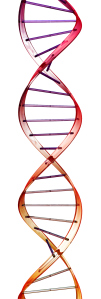The young researcher Matt Meselson must have been very excited when he pulled a photograph showing a series of grey stripes out of his wallet and passed it round at breakfast on New Year’s day 1958. Most of us might have a limited understanding of what he was celebrating, but his work has since been hailed as ‘the most beautiful experiment in biology’.
Last week marked the 60th anniversary of the publication of Watson and Crick’s famous Nature paper describing the structure of DNA. The now iconic helix was a bold idea based on data from the biophysicist Rosalind Franklin, and kick-started a revolution in biology. From the 1960s onwards, molecular biologists, including Matt Meselson, have been unravelling the secrets of the genome.
As a student in genetics I was taught the key experiments that helped scientists to accept that DNA was the molecule of inheritance, understand its information-carrying properties, and figure out how that information is passed on. I’m glad we didn’t have to reproduce this work in the laboratory because it was highly technical, rather tedious, and often involved the use of radioactive chemicals. With my impressive track record of spilling liquids, I’m not sure I would have survived! The resulting data, however, are beautifully simple and satisfyingly visual.
Perhaps the fuzzy grey bands that Meselson pushed under his friends’ noses that day would not look beautiful or simple to most people. To a biologist, however, the clear and visible demonstration of the ‘semiconservative’ replication of DNA by Meselson and his co-worker Frank Stahl is beauty itself. Something that looked rather boring – a series of grey stripes representing DNA with different chemical labels – has changed the way we see ourselves in a fundamental way.
Learning about what goes on inside every cell of my body at such a high level of detail has expanded my view of God. The world is incalculably complex and interconnected. Using our minds and our hands we can understand some of that complexity. For some of us, that will involve doing science. Others create technology, or use it in their everyday lives. Still others interpret the world through the arts. Though we cannot create something from nothing like God did, we can use our creativity to understand and live well in the world he created. In doing so, as astronomer Johannes Kepler said, we are thinking God’s thoughts after him.
This article was originally published by the London Institute for Contemporary Christianity as part of its ‘Connecting with Culture’ series, and is reposted here with permission.





